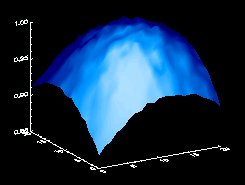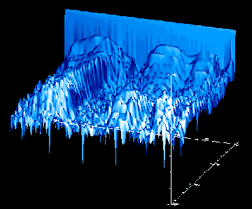|
PV-WAVE® is an array based programming language used to build and deploy Visual Data Analysis applications. These applications let users manipulate and visualize simple to extremely complex datasets to detect and display patterns, trends, anomalies and other vital information that would otherwise be overlooked in their data.
PV-WAVE delivers powerful image and signal processing, data import and export, 3D surface, plot, histogram, contour, animation, color editor and a database table display. This rapid data analysis and visualization combined with flexibility and power make PV-WAVE the choice among experts. And, unlike other products, PV-WAVE Advantage includes a sophisticated set of analysis routines based on the industry-standard IMSL Libraries for reliable and precise numerical analysis.
Application Areas
PV-WAVE includes powerful data visualization, advanced analysis and development tools that can dramatically decrease your time to insight, enabling you to seize opportunities, preempt your competitors, streamline your supply chain, enhance customer loyalty and increase your profitability. Our clients use PV-WAVE for a broad range of data mining and analysis activities including:
- Test Engineering
- Flight Test Engineering
- Medical Imaging
- Satellite Ground Stations
- Meteorological
- Time Series Analysis
- Profitability Analysis
- Variance Analysis
- Predictive Modeling
- Correlation Analysis
- Budget Forecasting
- Trend Analysis
- Regression Analysis
- Cluster Analysis
The PV-WAVE 4GL
A 4GL (Fourth-Generation Language) is an interpretive language designed to execute instructions as they are entered. 4GLs have several intrinsic benefits to users and developers:
- Higher-level instructions meaning a dramatic reduction in the amount of coding
- Real-time execution eliminates compiling and linking
- Reduced maintenance and support
The code example below illustrates the effectiveness of the PV-WAVE 4GL in loading and displaying a complex dataset:
Z = FLTARR (20,20)
status = DC_READ_FREE ("mydata.dat", Z)
SHADE_SURF, Z
This code loads data from a file "mydata.dat" and produces this image:

Because the language is so concise, PV-WAVE is an ideal tool for both small- and large-scale application developers.
Graphical Capabilities
PV-WAVE provides a tremendous variety of displays and plots, including:
- 2D, 3D and 4D plots
- 2D and 3D contours
- animation
- 2D, 3D and 4D vector plots
- wire mesh surfaces
- shaded surfaces
- Z-buffered graphics
- isosurfaces
- 2D and 3D polygons
- polar plots
- time series graphs
- scatter plots
- ray-tracing
- volumetric display
- histograms
- log/linear scaling
- image display
- colormap manipulation
- color lookup tables
- error graphs
- calendar axes
- translucency
- opacity
- maximum intensity projection
- mapping projections
- RGB-HSV-HLS
- glyphs
- annotation
Advanced Numeric Power
With PV-WAVE Advantage, the power of the IMSL advanced mathematics and statistics packages is at your fingertips. Powerful mathematical routines are available to make your programming more productive and provide you with the utmost in numerical power. The IMSL mathematical libraries provide a full range of capabilities, with subroutines for engineering, the sciences and other areas requiring accurate, reliable mathematical computation. The routines will save implementation time and help guarantee the accuracy of your results because you do not have to rely on implementing your own or public domain algorithms.
Image Processing
PV-WAVE Foundation provides a general purpose set of image display and image processing operations. When a more robust set of operations is required the PV-WAVE: Image Processing Toolkit is the right tool for the job. Included in the PV-WAVE: Image Processing Toolkit is an extensive set of filters, transforms and image processing operators designed to meet the needs of even the most demanding image processing application.
Signal Processing
 PV-WAVE's Signal-Processing Toolkit is a broad selection of predefined and customizable digital signal-processing functions designed to improve your data analysis and simulations. Filters are transfer function-based for easy design, analysis and realization of custom filters. The toolkit includes functions and procedures for the Fourier and wavelet analysis of a signal, as well as utilities and source code to facilitate custom function development. PV-WAVE's Signal-Processing Toolkit is a broad selection of predefined and customizable digital signal-processing functions designed to improve your data analysis and simulations. Filters are transfer function-based for easy design, analysis and realization of custom filters. The toolkit includes functions and procedures for the Fourier and wavelet analysis of a signal, as well as utilities and source code to facilitate custom function development.
Rapid Application Development Environment
PV-WAVE provides a powerful combination of features and capabilities that support a Rapid Application Development Environment (RADE). A suite of object-oriented methods, reusable interactive code and robust graphical and numerical capabilities are combined to give you the utmost in customizability and extensibility.
PV-WAVE's new high-level graphical interface components are the industry's most dramatic enhancement to data visualization. These tools utilize object-oriented methods that provide the user with a reusable modular framework and true "point-and-click" functionality for powerful data manipulation.
For end users, this "point and click" interface offers the simplicity to reduce or even eliminate programming. You can now spend more time doing actual analysis and reaching your decisions more quickly. Feature-full and function-rich PV-WAVE provides the ideal environment to help you reach the critical conclusions you need.
PV-WAVE provides you with an environment that is:
- Easy-to-use
- Customizable and extensible
- Cross-platform compatible
- Designed for both the technical end user and the application developer
The VDA Tools provide the individual components to speed your development, and the Navigator is a graphical user interface that incorporates all of the VDA Tools into a single "point-and-click" interface.
PV-WAVE Navigator
The Navigator is a graphical user interface included in PV-WAVE Advantage that allows you to quickly access a variety of interactive components for faster application development. A simple mouse click evokes these interactive components, called VDA Tools, where your data can be easily visualized, manipulated and analyzed. The modular framework of the Navigator also allows you to modify it and create custom interfaces for your specific application requirements.
- Users can perform specific functions such as generating plots, images, and contours, importing and exporting data; creating tables; and several other common procedures in an easy-to-use "point-and-click" environment available right out of the box.
- Ties together many of the VDA Tools into an end-user application.
- The Navigator can be extended for specific application requirements.
- The Navigator can be used as a template to develop your own GUI environment.
Data Import/Export
PV-WAVE supports numerous data file formats including:
- ASCII
- binary
- CSV
- TIFF
- BMP
- EMF
- X bitmaps
- CGM
- EPSI
- XDR
- HDF
- netCDF
- clipboard
It is also straightforward to implement readers and writers for both custom unformatted and formatted data using PV-WAVE's flexible import/export facilities.
Importing data from relational databases such as Oracle and Sybase is also a snap with either our optional direct links or the database developer's toolkit. Also, direct data interchange can be accomplished using built-in techniques such as:
- RPCs
- named pipes
- DDE
- dynamic linking
- memory sharing
- concurrent processes
PV-WAVE Debugger
PV-WAVE includes a powerful GUI-based symbolic debugger. The debugger provides functions such as:
- Set break points
- Monitor variables, strings and arrays
- Single stepping
- Search functions
- Direct execution of modified code without compiles or links
- Debugging of widget-based applications
PV-WAVE Data Management and Manipulation
PV-WAVE includes numerous tools designed to simplify the management and manipulation of datasets. PV-WAVE, together with its Toolkits, provides:
- thresholding
- high pass
- low pass
- band pass
- band-stop
- SQL queries
- date-time subsetting
- convolutions
- median, max, min
- smoothing
- parametric subsetting
- polynomial subsetting
- relational subsetting
- boolean subsetting
- histogram equalization
- contrast enhancement
- linear interpolation
- bilinear interpolation
- region of interest
- edge enhancement
- Digital Signal Processing
- projections
PV-WAVE Mapping
 PV-WAVE has extensive mapping support to the core product feature set. The mapping functions include: PV-WAVE has extensive mapping support to the core product feature set. The mapping functions include:
- 3D satellite projections.
- 16 predefined projections.
- Easy addition of user-defined projections.
- USGA database with resolution to the county level.
- Global database with more then 300k polygons
- Easy access to user databases.
- World map data with up-to-date political boundaries.
- Exact range scaling and aspect ratio.
- Labeled Contours.
- Support for polar maps.
- Algorithms for axes labels and grid lines.
- There are library tools for creating maps with color filled features, with a default database that supports filling by countries, US states, and oceans. This feature can be extended to fill any landscape element.
New features of PV-WAVE 9.0
- IMSL® C Library version 5.5 and 6.0 Integration – Access to many new algorithms including Auto_ARIMA forecasting and neural network engine for data mining and forecasting
- OpenMP support for Windows XP – Offers higher performance for PV-WAVE array operations on Windows
- Fast Radial Basis Functions -- New interpolation algorithm that accommodates very general datasets
- Eclipse Plug-in – Allows users to leverage the Eclipse open source integrated development environment (IDE) for development and debugging, and enables new users to more quickly become proficient with PV-WAVE
- Additional Platform Support – Provides users with additional options for using PV-WAVE in different hardware and software environments including Oracle (Linux 32 and 64 bit, Solaris 64 bit) and Windows XP 64 bit
|









